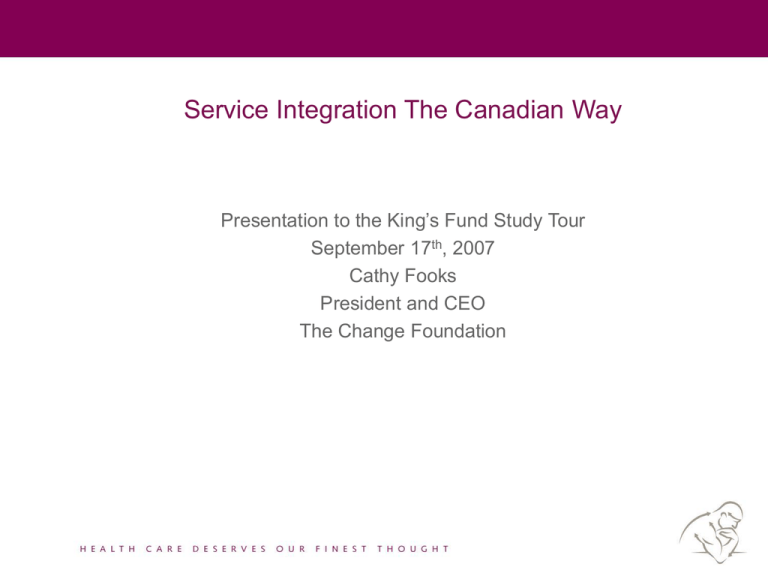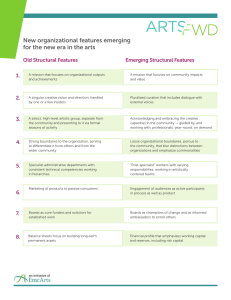Toward a Model of Integrated Care, 2000 Leatt et al.
advertisement

Service Integration The Canadian Way Presentation to the King’s Fund Study Tour September 17th, 2007 Cathy Fooks President and CEO The Change Foundation Presentation Overview • Structure of Canadian health system • Regionalization in Canada • Ontario version of integration • Implications for patient outcomes • Predictions for the future Structure of Canadian Health System • Health care delivered by provinces and territories with some federal funding • Amount of federal funding negotiated and subject of much argument • The Canada Health Act gives funding authority and covers physician care and services delivered in hospital. Different ways that private care is dealt with across jurisdictions. • Everything else is up to p/ts thus significant variation across the country Structure of Canadian Health Care System • Physicians are largely in private practice, on a fee for service basis – gradually changing to more group practice based on capitation and program funding • Drugs are privately covered, often through employment benefits with some public funding for elderly or low income individuals • Very little quality oversight, public reporting of outcomes • Very little experience with purchasing service, contracting or commissioning Expenditure per capita by source of funding, 2004 Japan 1832 389 28 2176 UK 1940 Australia 370 582 354 public out of pocket private Germany 2350 313 342 2210 Canada 472 483 2727 US 0 1000 803 2000 3000 2572 4000 5000 6000 7000 System Design “Canada has a series of disconnected parts, a hodge-podge patchwork, health care industry comprised of hospitals, doctors offices, group practices, community agencies, private sector organizations, public health departments and so on.” Toward a Model of Integrated Care, 2000 Leatt et al. Reform Reviews in All Provinces • Common themes – need for: – – – – – Primary care reform Regionalization Reigning in of drug expenditures Increased spending in home care/community A focus on non medical determinants of health Move to Regionalize – mid 1990s • Everywhere but Ontario • Ontario had at the time District Health Councils – Ministerially appointed local individuals to provide advice to the Minister • Health Services Restructuring Commission – legal authority to mandate merger/closure of hospitals – saw some amalgamation at governance level but most physical plants were kept and/or redeveloped Timing • Initial efforts at reform coincided with multi year reductions in the federal transfers (which have subsequently been increased up to previous levels) • Choices for provinces to cut, cover the federal portion or reorganize • Ontario chose to cover, the rest of the country reorganized Lessons from the Initial Regionalization Experience 1a) Had to fiddle with the numbers – • BC went from 9 to 5 • Alberta went from 17 to 9 • Saskatchewan went from 32 to 12 • Nova Scotia went from four regional boards to 9 district authorities 1b) still need provincial authority to tertiary care (eg, cancer, transplants) Current Numbers Against Population Jurisdiction BC Alberta Saskatchewan Manitoba Ontario Quebec Nova Scotia New Brunswick PEI N&L NWT Nunavut The Yukon # of Regions 5 regions and 1 provincial authority 9 regions and provincial cancer board 12 regions and provincial cancer agency 11 regions and provincial cancer agency 14 LHINs and provincial cancer agency and provincial cardiac care network 18 regions and 95 local service networks 9 districts 7 regions No regions, 5 community hospital boards 6 regions with 15 health boards 8 health and social service regions No regions No regions Population, April 2007 4,352,800 3,455060 990,210 1,182,920 12,753,700 7,687,060 932,970 748,880 138,800 506,550 41,795 31,220 30,880 Lessons from the Initial Experience 2) Experimented with Public Participation – quick decision to dump it • Saskatchewan elected 2/3rds of its Boards but moved to wholly appointed Boards • Quebec had elected Boards by representative assemblies but moved to wholly appointed Boards • Alberta had directly elected Boards but moved to wholly appointed • Some form of advisory council or committee created in some jurisdictions Lessons from the Initial Experience 3) Lack of clarity around roles and responsibilities • Survey done by the Centre for the Analysis of Regionalization and Health (2003) found that: – Majority of respondents found that division of responsibility was unclear – CEOs felt that residents had a tendency to bypass the Boards and present issues to the province – Boards felt they had less authority than they should – Ministry felt the RHAs were not restricted in their authority and that special interests had too much influence in decisions Made in Ontario • Ministry of Health and Long Term Care is steward • LHINS- regional planning and eventual resource allocation (although Ministry has already set three year budgets) • CCACs – purchase for home care and LTC • Providers – maintaining separate governance for now • Physicians outside any accountability system other than professional self regulation and some performance targets with financial incentives for family health teams LHINS and Regions: Key Differences (S. Lewis, 2007) Feature LHINS RHAs Hold budget for community care, hospitals, LTC Boards appointed by MOH √ √ √ √ Boards/CEO have clear authority over services in their area Mandate to manage programs and services directly Responsible for MDs and drugs ? √ X √ X X X √ Fewer local boards with reduced power Critical Differences LHINS Purchasers, funders within Ministry allocation Employ only their own central staff Exercise authority through accountability and service agreements Agreements with independent providers boards RHAs Purchasers, funders and managers of services within negotiated budget Major regional employer Direct authority as employer and service agreements with affiliates Very few independent provider boards Physician Report Use of Multi Disciplinary Teams and NonPhysician Clinicians, 2006 51 New Zealand 30 70 UK 81 38 Australia 32 56 Germany 49 22 Canada 32 39 US 29 0 10 20 30 40 % use multidisciplinary teams 50 60 % use non-MD clinicians 70 80 90 Primary Care MDs Use of Information Technology, 2006 80 NZ 92 92 UK 89 68 Australia 79 81 Germany 42 26 Canada 23 37 US 28 0 10 20 30 % MDs using electronic record 40 50 60 70 80 % of primary care practices generating list of pts by diagnosis 90 100 Quality Measures, 2006 49 NZ 41 65 UK 70 39 Australia 26 22 Germany 70 46 Canada 27 37 US 50 0 10 20 30 % MDs set formal targets for clincial performance 40 50 60 70 % MDs reporting problems due to poorly coordinated care 80





